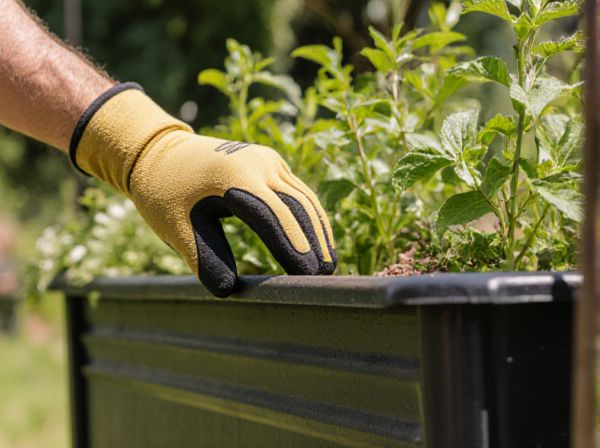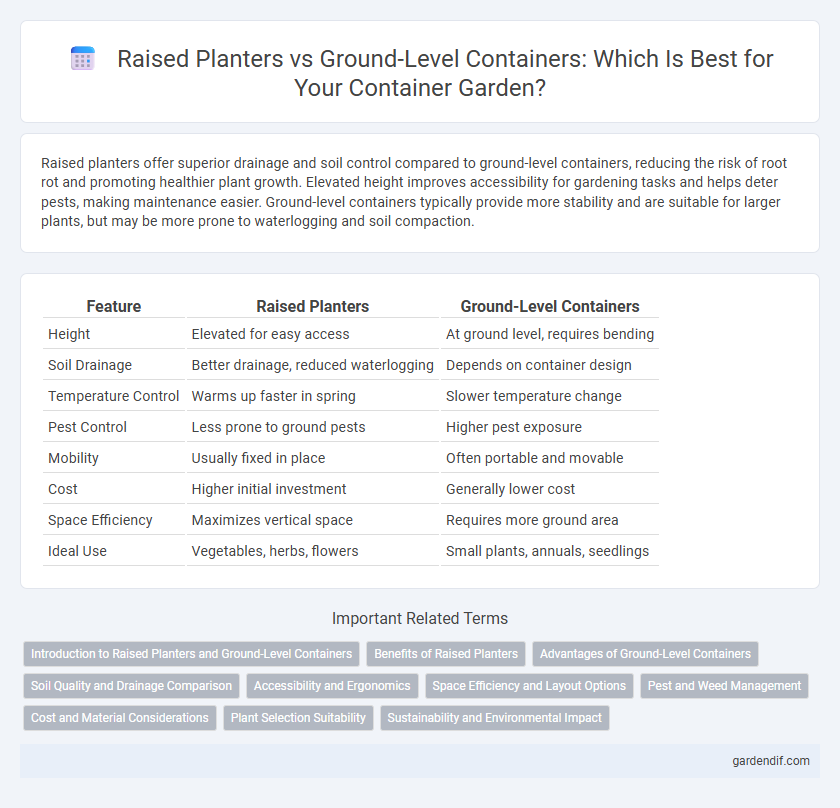
Raised planters vs ground-level containers Illustration
Raised planters offer superior drainage and soil control compared to ground-level containers, reducing the risk of root rot and promoting healthier plant growth. Elevated height improves accessibility for gardening tasks and helps deter pests, making maintenance easier. Ground-level containers typically provide more stability and are suitable for larger plants, but may be more prone to waterlogging and soil compaction.
Table of Comparison
| Feature | Raised Planters | Ground-Level Containers |
|---|---|---|
| Height | Elevated for easy access | At ground level, requires bending |
| Soil Drainage | Better drainage, reduced waterlogging | Depends on container design |
| Temperature Control | Warms up faster in spring | Slower temperature change |
| Pest Control | Less prone to ground pests | Higher pest exposure |
| Mobility | Usually fixed in place | Often portable and movable |
| Cost | Higher initial investment | Generally lower cost |
| Space Efficiency | Maximizes vertical space | Requires more ground area |
| Ideal Use | Vegetables, herbs, flowers | Small plants, annuals, seedlings |
Introduction to Raised Planters and Ground-Level Containers
Raised planters elevate soil above ground level, improving drainage and soil quality control, which benefits root development and plant health. Ground-level containers sit directly on the soil or surface, allowing easier access and integration with existing garden beds but may face challenges such as soil compaction and water retention. Both options offer distinct advantages depending on plant type, gardening space, and maintenance preferences.
Benefits of Raised Planters
Raised planters offer improved soil drainage and aeration compared to ground-level containers, promoting healthier root development. They reduce soil compaction and provide better pest control by elevating plants above common ground-dwelling insects and weeds. Enhanced accessibility makes raised planters ideal for gardeners with mobility challenges, allowing easier planting, maintenance, and harvesting.
Advantages of Ground-Level Containers
Ground-level containers offer superior insulation for plant roots, maintaining more consistent soil temperatures that promote healthy growth. They provide easier access for watering and maintenance compared to raised planters, reducing strain during gardening tasks. Additionally, ground-level containers allow for natural drainage and better integration with existing soil ecosystems, enhancing nutrient availability.
Soil Quality and Drainage Comparison
Raised planters offer superior soil quality control by allowing gardeners to fill them with nutrient-rich, well-draining soil tailored to plant needs, unlike ground-level containers which may suffer from soil compaction and poor organic matter. Drainage is often more efficient in raised planters due to elevated positioning and customizable drainage holes, reducing waterlogging risks common in ground-level options. This setup promotes healthier root development and mitigates soil-borne diseases through improved aeration and moisture management.
Accessibility and Ergonomics
Raised planters offer enhanced accessibility by minimizing the need to bend or kneel, making gardening more comfortable for individuals with mobility challenges or back issues. Ground-level containers require more frequent bending, which can strain joints and muscles during planting and maintenance. Incorporating raised planters improves ergonomic posture and reduces physical fatigue, supporting longer, more enjoyable gardening sessions.
Space Efficiency and Layout Options
Raised planters optimize space efficiency by elevating soil depth without expanding the footprint, allowing denser planting and better drainage compared to ground-level containers. They offer versatile layout options, including tiered arrangements and modular designs, enabling gardeners to maximize limited garden areas effectively. Ground-level containers provide limited space flexibility and can restrict plant growth due to shallower soil depth and less efficient use of vertical space.
Pest and Weed Management
Raised planters offer enhanced pest and weed management by creating a physical barrier that reduces soil-borne pests and limits weed seed intrusion. Ground-level containers are more vulnerable to weed growth and insect infestations due to direct contact with surrounding soil and vegetation. Implementing proper mulch, regular inspection, and selective organic pesticides further optimizes pest and weed control in both container types.
Cost and Material Considerations
Raised planters typically require more initial investment due to the need for quality lumber, hardware, and sometimes liners, making materials like cedar or composite wood popular for durability and rot resistance. Ground-level containers often utilize plastic, ceramic, or metal, which are generally more affordable upfront but may lack the longevity and insulation properties of raised beds. Cost efficiency depends on the balance between material durability and the necessity for soil containment, drainage, and ease of maintenance.
Plant Selection Suitability
Raised planters offer superior soil drainage and temperature control, making them ideal for delicate plants such as herbs, succulents, and shallow-rooted vegetables like lettuce and spinach. Ground-level containers accommodate a wider variety of plant types, including deep-rooted vegetables like tomatoes, peppers, and root crops such as carrots and beets, due to greater soil volume. Selecting the appropriate container depends on the specific plant's root depth, moisture needs, and tolerance to temperature fluctuations.
Sustainability and Environmental Impact
Raised planters minimize soil compaction and improve water drainage, promoting healthier root growth and reducing runoff pollution compared to ground-level containers. Their elevated design allows for better insulation, which conserves water and moderates soil temperature, enhancing plant resilience and resource efficiency. Ground-level containers often require more frequent watering and can contribute to soil degradation, making raised planters a more sustainable choice for environmentally conscious gardening.
Raised planters vs ground-level containers Infographic

 gardendif.com
gardendif.com